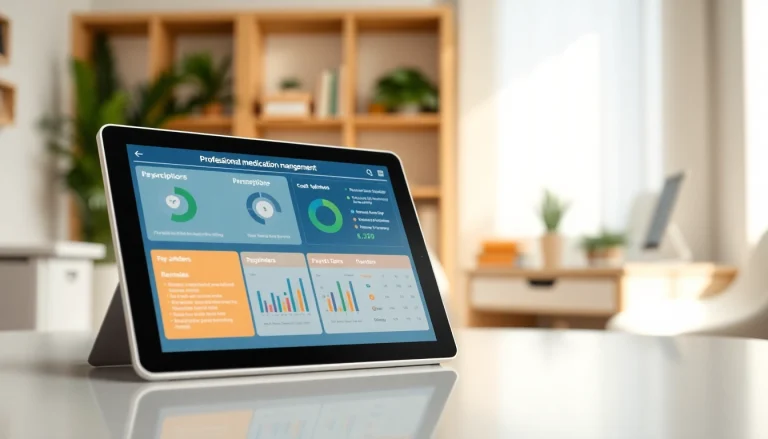
Understanding E-Prescribing
E-prescribing is not just a trend in the healthcare sector; it represents a significant evolution in how prescriptions are managed and delivered. Efforts towards digitizing this process have made it crucial for medical practitioners to choose effective tools that maximize patient safety and streamline workflows. The rise of various e-prescription applications has transformed traditional prescription writing into more efficient, secure, and simple practices. In this article, we will explore best eprescription apps, examine their features, and consider how they can improve overall healthcare delivery.
The Basics of E-Prescription Approaches
E-prescribing involves the electronic transmission of prescription orders from healthcare providers to pharmacies. It eliminates the traditional paper-based method, where prescriptions were handwritten and often prone to misinterpretation. The basic components of e-prescribing include:
- Electronic Communication: Prescriptions are sent digitally, ensuring accuracy and efficiency.
- Integration with Health Records: Most e-prescribing systems are integrated with electronic health record (EHR) systems, allowing for seamless access to a patient’s medical history.
- Medication History: Healthcare providers can access a patient’s previous medication history, which helps make informed prescribing decisions.
- Patient Safety: E-prescribing reduces the potential for medication errors due to illegible handwriting or miscommunication.
The Importance of Compliance and Security in E-Prescribing
Compliance with healthcare regulations like the Health Insurance Portability and Accountability Act (HIPAA) is non-negotiable in the digital age. Security features must be a top priority for any e-prescribing solution to protect sensitive patient information. Key aspects of compliance include:
- Data Encryption: Encrypting data ensures that unauthorized users cannot intercept or interpret sensitive information.
- Audit Trails: Maintaining records of all prescription transactions helps in tracking changes and ensuring accountability.
- User Authentication: Strong authentication mechanisms prevent unauthorized access, protecting patient data from potential breaches.
Benefits of Using E-Prescribing Applications
The shift to e-prescribing brings several benefits that enhance both patient care and operational efficiency:
- Improved Accuracy: Digital submissions minimize the risk of errors caused by handwritten prescriptions.
- Speed: E-prescribing expedites the process of getting medications to the pharmacy, improving patient satisfaction.
- Cost-Effectiveness: Reducing prescription errors can lead to less waste and lower costs, benefiting healthcare providers and patients alike.
- Enhanced Patient Engagement: Many e-prescription apps provide patients with direct access to their medication information, fostering shared decision-making.
Features to Look for in the Best E-Prescription Apps
Selecting the right e-prescribing app is crucial for healthcare providers. Below are essential features to consider when evaluating potential solutions:
User-Friendly Interface for Medical Professionals
An intuitive user interface streamlines the e-prescribing process. Medical professionals often operate under time constraints, and a complex system can lead to frustration and reduced productivity. A well-designed interface should:
- Enable quick access to prescription writing tools.
- Include features like pre-populated dosage information to save time.
- Provide straightforward navigation for ease of use during busy practices.
Integration with Existing Healthcare Systems
The effectiveness of an e-prescribing application greatly depends on its ability to integrate with current healthcare systems, particularly EHR platforms. Effective integration helps in:
- Reducing data entry duplication, which saves time.
- Providing consolidated patient information, facilitating better clinical decisions.
- Enhancing overall workflow efficiency, leading to improved patient care.
Support and Training Options for Users
Comprehensive support and training are critical components of transitioning to an e-prescribing solution. Healthcare providers should look for:
- Robust onboarding processes to get staff familiar with the new system.
- Access to resources such as tutorials and customer support channels.
- Regular updates and ongoing education to keep users informed about new features or regulatory changes.
Top Considerations for Selecting E-Prescribing Software
Choosing the right e-prescribing software involves careful evaluation across several dimensions. Below, we discuss key considerations:
Evaluating Cost-Effectiveness of E-Prescribing Solutions
While it may be tempting to choose the cheapest option available, it’s essential to evaluate the cost in relation to the software’s features and the potential return on investment. Considerations should include:
- Initial setup and ongoing maintenance costs.
- Licensing fees and any additional charges for features or upgrades.
- Overall impact on practice efficiency and patient care.
Assessing Software Scalability and Flexibility
As healthcare practices grow, it’s vital that their e-prescribing solutions can scale accordingly. When evaluating software, look for:
- Options to add more users or features as the practice expands.
- Customization capabilities to meet unique practice requirements.
- Compatibility with various devices for flexibility in usage.
Checking for Comprehensive Customer Support
Reliable customer support can make a substantial difference in the successful implementation of e-prescribing software. Essential support features include:
- 24/7 availability for urgent issues.
- Well-documented resources for troubleshooting common problems.
- Feedback mechanisms for continuous improvement based on user experience.
Comparative Analysis of Popular E-Prescription Apps
Given the numerous options available, a thorough comparative analysis can shed light on the strengths and shortcomings of various e-prescription apps. Exploring different aspects in detail provides a clearer image of the best choices.
Feature Comparisons Among Key E-Prescribing Platforms
A strong feature set can differentiate top e-prescribing applications. When comparing platforms, consider:
- Prescription management capabilities, including refill requests and medication changes.
- Integration options with pharmacy management systems.
- Mobile access for on-the-go prescription management.
User Reviews and Testimonials on App Performance
User feedback is invaluable when assessing the viability of an e-prescribing solution. Highlighted aspects include:
- Overall satisfaction with the software functionality and interface.
- Feedback regarding customer support experiences.
- Common issues faced along with their corresponding solutions provided by the software.
Emerging Trends in E-Prescription Software
The landscape of e-prescribing is constantly evolving. Key emerging trends that can potentially shape the future of e-prescription applications include:
- Advancements in telehealth integration for a more holistic patient experience.
- Utilization of artificial intelligence to enhance decision-making capabilities.
- Increased patient control over their medication information, providing transparency and fostering trust.
Implementing E-Prescription Solutions
Successfully integrating e-prescribing software into a practice requires more than just software installation. A strategic approach ensures smooth transition and effective utilization of the new system.
Steps for Successful Integration into Practice
Implementing a new e-prescribing solution involves multiple steps that necessitate careful planning, including:
- Assessing the current workflow to identify areas for improvement.
- Selecting appropriate software that aligns with the practice’s needs.
- Planning the timeline for rollout, ensuring minimal disruption to day-to-day operations.
Training Staff on New E-Prescribing Tools
Staff training is critical to maximize the benefits of e-prescribing solutions. Training initiatives should focus on:
- Comprehensive tutorials that cover all features of the software.
- Hands-on practice sessions to build confidence in using the application.
- Feedback from staff to identify any difficulties encountered during training for further refinement.
Measuring Outcomes and Efficiency Post-Implementation
To ensure that the e-prescribing solution aligns with practice goals, continuous monitoring of its effectiveness is necessary. Important performance metrics include:
- Reduction in prescription errors compared to the previous system.
- Time savings in processing prescriptions.
- Patient feedback regarding the ease of obtaining medications.
In conclusion, selecting the right e-prescribing application is a crucial decision for healthcare providers looking to optimize their prescription management processes. With a focus on compliance, cost-effectiveness, and overall user experience, the best eprescription apps can lead to increased efficiency and enhanced patient safety. By thoughtfully considering the outlined features, integration strategies, and monitoring outcomes, practices can successfully transition to a digital prescribing model that ultimately benefits their patients and the healthcare system as a whole.






